Conosciamo la sensazione. Quel momento di sconforto in cui il vostro sito va giù e non avete idea del perché. È uno degli errori più comuni di WordPress, ma anche uno dei più misteriosi. Non vi dice cosa c’è che non va, ma solo che qualcosa è rotto.
La buona notizia? È quasi sempre risolvibile. Avendo aiutato innumerevoli personalizzati, abbiamo avuto a che fare con questo errore molto spesso.
In questa guida vi illustreremo i passaggi esatti per ripristinare il vostro sito e renderlo funzionante. Seguiteci e vedrete che tutto tornerà a funzionare in pochissimo tempo.
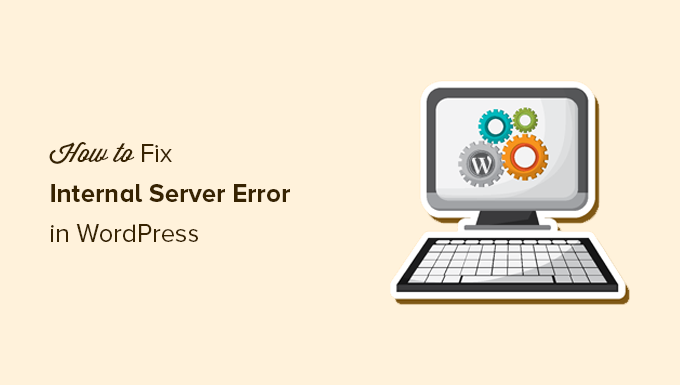
Ecco una rapida panoramica degli argomenti che tratteremo in questo articolo:
- What Is the 500 Internal Server Error?
- What Causes the Internal Server Error in WordPress?
- Fixing the 500 Internal Server Error in WordPress
- Clear WordPress and Browser Cache
- Checking for Corrupt .htaccess File
- Increasing the PHP Memory Limit
- Deactivate All WordPress Plugins
- Switch to a Default WordPress Theme
- Re-Uploading Core Files
- Enable Debug Logs in WordPress
- Ask Your Hosting Provider
- Video Tutorial
Che cos’è l’errore 500 Internal Server?
L’errore 500 Internal Server è come una porta bloccata senza chiave. Si sa che qualcosa non va, ma non c’è una nota che spieghi cosa è successo.
Questo errore non riguarda solo WordPress. Può apparire su qualsiasi sito web quando il server incontra un problema che non sa come gestire.
Il “500” nel messaggio è un codice di stato HTTP. Se lo cercate, troverete una definizione vaga:
“Il codice di risposta 500 Internal Server Error indica che il server ha incontrato una condizione inaspettata che gli ha impedito di soddisfare la richiesta”.
Non è molto utile, vero? È il modo in cui il server dice: “Si è rotto qualcosa, ma non sono sicuro di cosa”.
L’aspetto di questo errore dipende dalla configurazione dell’host e dal browser. Ecco un esempio di come appare su un server Apache:
Se il sito viene eseguito su Nginx, l’aspetto potrebbe essere leggermente diverso. Se Google Chrome non riesce a caricare una pagina di errore corretta, si vedrà qualcosa di simile:
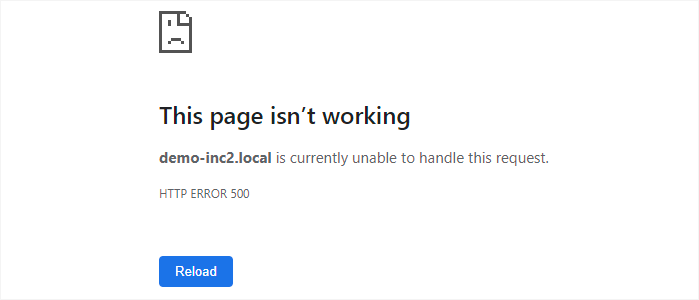
Per i principianti, questa situazione può risultare sconvolgente. Non c’è alcun messaggio che indichi cosa è andato storto o come correggerlo.
È come chiedere a un meccanico di correggere la vostra auto senza dirgli cosa è rotto. Dovranno controllare diverse parti fino a trovare il problema.
In base alla nostra esperienza, il modo migliore per correggere il problema è procedere passo dopo passo. Vi illustreremo le cause e le soluzioni più comuni per far sì che il vostro sito torni a funzionare.
Ottenete l’aiuto di un esperto in qualsiasi momento con il supporto WordPress on-demand!
Affrontare un errore interno del server può essere frustrante. Il nostro Supporto WordPress On-Demand è qui per aiutarvi a correggere i problemi tecnici in modo rapido ed efficace.
- Pagamento unico per l’assistenza on-demand di un esperto
- Tempi di consegna rapidi
- Disponibile 24 ore su 24, 7 giorni su 7
👉 O ttenete subito un supporto di emergenza per WordPress! 🛠️
Cosa causa l’errore interno del server in WordPress?
L’errore interno del server in WordPress è come un puzzle con pezzi mancanti. Sapete che qualcosa non va, ma il messaggio di errore non vi dice esattamente dove si trova il problema.
In base alla nostra esperienza, il colpevole più comune è un file .htaccess corrotto. A volte, si tratta di un plugin che si comporta male o di un tema che non funziona bene con la vostra configurazione.
Altre volte, il sito può colpire il limite di memoria PHP, causando il blocco di WordPress. Anche i file del core corrotti possono innescare questo errore, lasciandovi bloccati senza attenzione.
In alcuni casi, l’errore appare solo quando si cerca di accedere all’area di amministrazione di WordPress, mentre il resto del sito funziona correttamente. È come essere bloccati in casa propria mentre gli ospiti possono ancora entrare dalla porta sul retro.
Ciò che rende questo errore complicato è che di solito si verifica prima che WordPress possa essere caricato correttamente. Ciò significa che il server non può raccogliere abbastanza dettagli per spiegare cosa è andato storto.
Se volete dare un’occhiata più approfondita al funzionamento di WordPress dietro le quinte, consultate la nostra guida su come WordPress opera sotto il cofano.
Passiamo ora alla risoluzione dei problemi per ripristinare il funzionamento del sito.
Risolvere l’errore 500 Internal Server in WordPress
Prima di iniziare la risoluzione dei problemi, assicuratevi di avere a portata di mano un backup completo di WordPress del vostro sito web.
Se avete accesso all’area di amministrazione di WordPress, potete utilizzare un plugin di backup per WordPress per creare un backup completo del vostro sito web.
Per questo consigliamo di utilizzare Duplicator. Non solo vi aiuta a eseguire rapidamente il backup del vostro sito web, ma potete anche archiviare i vostri backup sul cloud e, soprattutto, potete ripristinare il vostro sito web dal backup.
D’altra parte, se non avete accesso all’area di amministrazione di WordPress, potete creare manualmente un backup di WordPress utilizzando phpMyAdmin e un client FTP.
In seguito, potete seguire i seguenti passaggi per risolvere il problema e risolvere l’errore del server interno sul vostro sito web.
Cancellare la cache di WordPress e del browser
I browser e i plugin di caching di WordPress possono talvolta memorizzare erroneamente una copia in cache di una pagina di errore.
Il modo più semplice per risolvere il problema è cancellare la cache del browser.
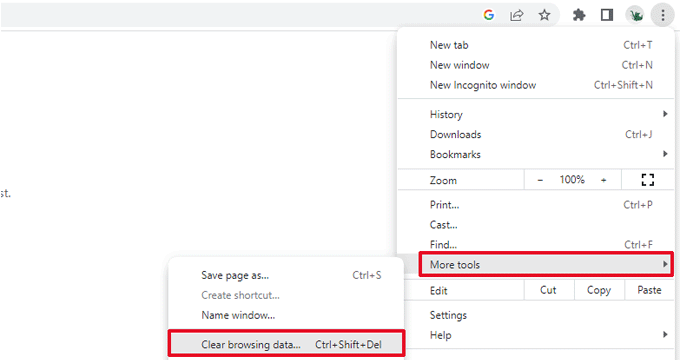
Dopodiché, se avete accesso all’area di amministrazione di WordPress del vostro sito web, potete svuotare la cache di WordPress visitando la pagina delle impostazioni del vostro plugin di caching.
Per maggiori dettagli, consultate il nostro tutorial su come cancellare la cache di WordPress.
Verifica della presenza di un file .htaccess corrotto
Il file .htaccess è un file di configurazione del server utilizzato da WordPress per impostare i reindirizzamenti.
Una delle cause più comuni di errore interno del server è il file .htaccess corrotto.
Il modo più semplice per correggere questo problema è semplicemente visitare la pagina Impostazioni ” Permalinks nell’area di amministrazione di WordPress e poi fare clic sul pulsante “Salva modifiche” senza apportare alcun cambiamento.
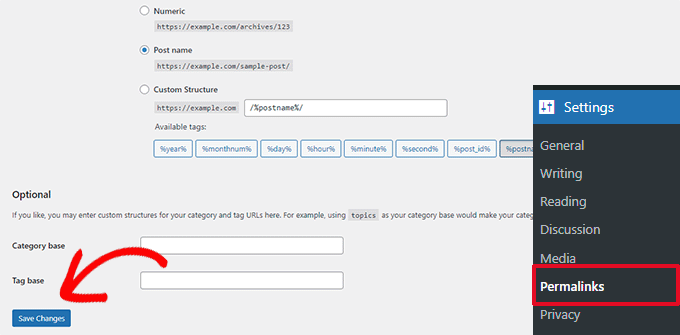
WordPress cercherà ora di aggiornare il file .htaccess o di generarne uno nuovo. Ora è possibile visitare il sito web per verificare se l’errore del server interno è stato corretto.
Se l’errore è ancora visibile, è necessario assicurarsi che WordPress sia stato in grado di generare o scrivere sul file .htaccess.
A volte, a causa delle autorizzazioni di file e directory, WordPress potrebbe non essere in grado di creare o scrivere sul file .htaccess.
Ora potete provare a sostituire il file .htaccess manualmente. Per prima cosa, dovete accedere al vostro sito web utilizzando l’FTP o l’applicazione File Manager nel pannello di controllo del vostro account di hosting.
Successivamente, è necessario rinominare ilfile .htaccess principale in qualcosa come .htaccess_old. Questo vi consente di mantenere il file come backup, ma WordPress non lo riconoscerà.
Per rinominare il file .htaccess, dovrete accedere al vostro sito utilizzando l’FTP o l’applicazione File Manager nel cruscotto del vostro account di hosting.
Una volta collegati, il file .htaccess si troverà nella stessa directory in cui sono presenti cartelle come wp-content, wp-admin e wp-includes.
È sufficiente fare clic con il tasto destro del mouse sul file .htaccess e rinominarlo in .htaccess_old.
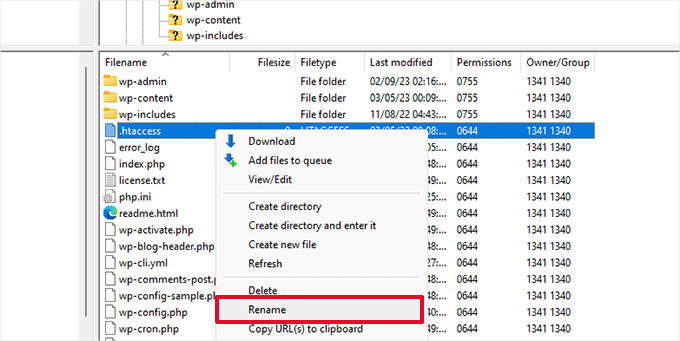
Successivamente, è necessario creare un nuovo file .htaccess.
All’interno della cartella principale del sito, fare clic con il tasto destro del mouse e selezionare l’opzione “Crea nuovo file” nel client FTP o nell’applicazione File Manager.
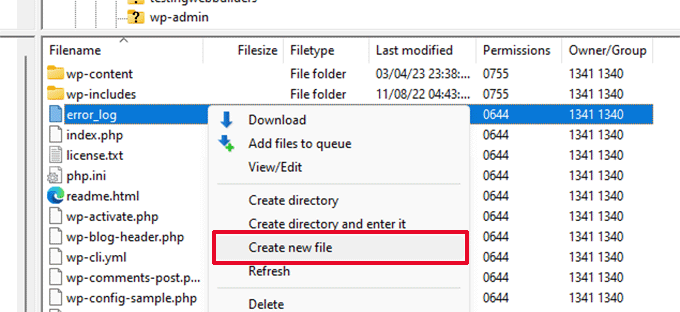
Nominate questo nuovo file .htaccess e fate clic su “OK” per salvarlo.
Ora, questo file .htaccess è attualmente vuoto ed è necessario aggiungervi le regole di riscrittura predefinite di WordPress.
È sufficiente fare clic con il tasto destro del mouse sul file e selezionare “Visualizza/Modifica” nel client FTP o nell’applicazione File Manager.
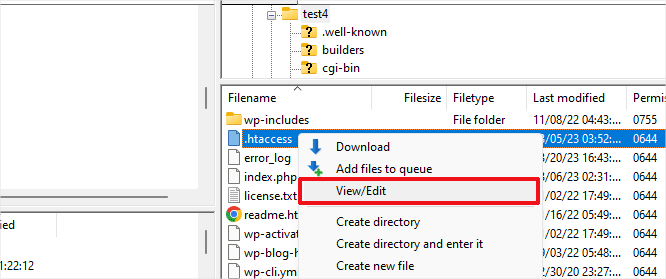
Il file vuoto si aprirà in un editor di testo semplice come Notepad o TextEdit.
A questo punto, è necessario copiare e incollare il seguente codice al suo interno:
1 2 3 4 5 6 7 8 9 10 | # BEGIN WordPress<IfModule mod_rewrite.c>RewriteEngine OnRewriteBase /RewriteRule ^index.php$ - [L]RewriteCond %{REQUEST_FILENAME} !-fRewriteCond %{REQUEST_FILENAME} !-dRewriteRule . /index.php [L]</IfModule># END WordPress |
Questo codice è il set di regole predefinito utilizzato da WordPress. Non dimenticate di salvare le modifiche e di caricare il file sul server.
Ora è possibile visitare il sito web per verificare se l’errore del server interno è stato risolto.
In caso affermativo, allora datevi una pacca sulla spalla perché avete risolto l’errore interno del server.
Importante: prima di procedere con altre operazioni, assicuratevi di andare alla pagina Impostazioni ” Permalinks nell ‘area di amministrazione di WordPress e di fare clic sul pulsante Salva senza apportare alcuna modifica. In questo modo il file .htaccess verrà rigenerato con regole di riscrittura adeguate per garantire che le pagine dei vostri post non restituiscano un errore 404.
Se la soluzione per verificare la presenza di un file .htaccess corrotto non ha funzionato, allora dovete continuare a leggere questo articolo.
Aumentare il limite di memoria di PHP
A volte, l’errore interno del server può verificarsi se uno script consuma tutto il limite di memoria di PHP.
Il modo più semplice per aumentare il limite di memoria di PHP è modificare il file wp-config.php. Se siete principianti, fate attenzione a questa operazione. Seguite attentamente queste istruzioni, perché anche piccoli errori nei file principali di WordPress possono danneggiare il vostro sito.
Per iniziare, è sufficiente collegarsi al proprio sito web WordPress utilizzando un client FTP o l’applicazione File Manager nel pannello di controllo del proprio account di hosting.
Il file wp-config.php si trova nella cartella principale del vostro sito web. Fate clic con il tasto destro del mouse su di esso e selezionate “Scarica”. In questo modo vi assicurerete di avere un file di backup nel caso in cui qualcosa vada storto.
Una volta salvato, è possibile fare clic con il pulsante destro del mouse e selezionare “Visualizza/Modifica”.
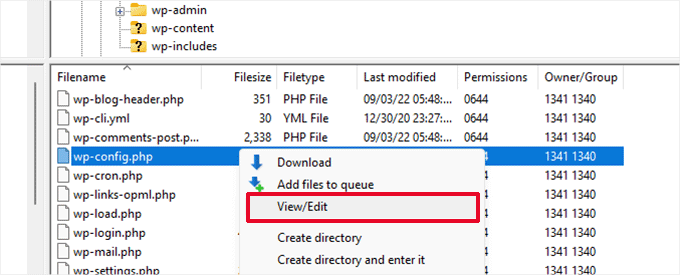
All’interno del file wp-config.php, è necessario aggiungere il seguente codice appena sopra la riga che recita: “Questo è tutto, smettete di modificare! Buona pubblicazione”:
1 | define( 'WP_MEMORY_LIMIT', '256M' ); |
Per maggiori dettagli, consultate il nostro tutorial su come aumentare il limite di memoria PHP in WordPress.
Nota: se 256M non risolve il problema, provare ad aumentare a 512M.
Se l’errore del server interno viene visualizzato solo quando si tenta di accedere all’amministrazione di WordPress o di caricare un’immagine in wp-admin, allora è necessario aumentare il limite di memoria seguendo questi passaggi:
- Creare un file di testo vuoto sul computer e chiamarlo php.ini.
- Incollare questo codice: memoria=256MB
- Salvare il file
- Caricate il file nella cartella /wp-admin/ tramite FTP.
Se l’aumento del limite di memoria ha risolto il problema, allora il problema è stato risolto solo temporaneamente. È ancora necessario trovare la causa che sta esaurendo il limite di memoria.
Potrebbe trattarsi di un plugin mal codificato o anche di una funzione del tema. Vi consigliamo vivamente di chiedere alla vostra società di web hosting WordPress di esaminare i log del server per aiutarvi a trovare la diagnostica esatta.
Se l’aumento del limite di memoria di PHP non ha corretto il problema, è necessario risolvere altri problemi.
Disattivare tutti i plugin di WordPress
Se nessuna delle soluzioni precedenti ha funzionato, è molto probabile che l’errore sia causato da un plugin specifico installato sul vostro sito web.
È anche possibile che si tratti di una combinazione di plugin che non funzionano bene tra loro.
Se potete accedere all’area di amministrazione di WordPress del vostro sito web, potete semplicemente andare alla pagina dei plugin e disattivare tutti i plugin di WordPress.
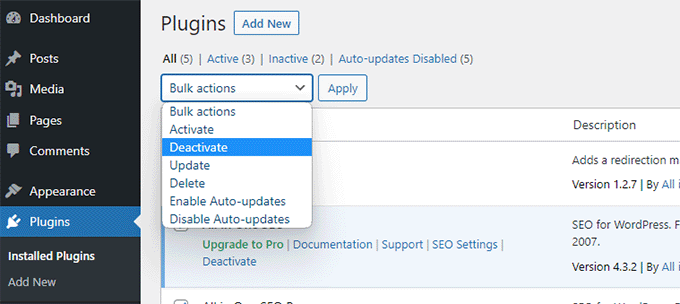
Tuttavia, se non riuscite ad accedere all’area di amministrazione di WordPress, potete disattivare tutti i plugin di WordPress utilizzando l’FTP.
È sufficiente collegarsi al proprio sito Web WordPress utilizzando un client FTP o l’applicazione di gestione dei file nel pannello di controllo del proprio account di hosting.
Una volta collegati, navigare nella cartella /wp-content/ e rinominare la cartella plugins in plugins.deactivated.
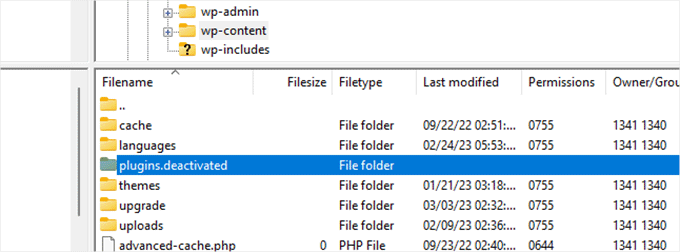
WordPress cerca i plugin nella cartella plugins. Se la cartella plugins non viene trovata, disattiverà automaticamente tutti i plugin.
Ora potete provare a visitare il vostro sito web per verificare se questo ha risolto l’errore del server interno sul vostro sito web.
Per ripristinare tutti i plugin, è sufficiente rinominare la cartella ‘plugins.deactivated’ in plugins.
I plugin verranno ripristinati, ma saranno ancora disattivati.
Ora è possibile attivare i singoli plugin e visitare il sito web per capire quale plugin sta causando l’errore interno del server.
Per maggiori dettagli, consultate la nostra guida su come disattivare tutti i plugin di WordPress senza wp-admin.
Se la disattivazione di tutti i plugin non ha risolto l’errore interno del server sul vostro sito web, continuate a leggere.
Passare a un tema WordPress predefinito
Una possibile causa dell’errore del server interno potrebbe essere un codice del tema di WordPress.
Per determinare se questo è il caso, è necessario cambiare il tema con un tema predefinito di WordPress.
Se avete accesso all’area di amministrazione di WordPress, andate alla pagina Aspetto ” Temi. Se è già installato un tema predefinito, è sufficiente fare clic sul pulsante Attiva per cambiare il tema.
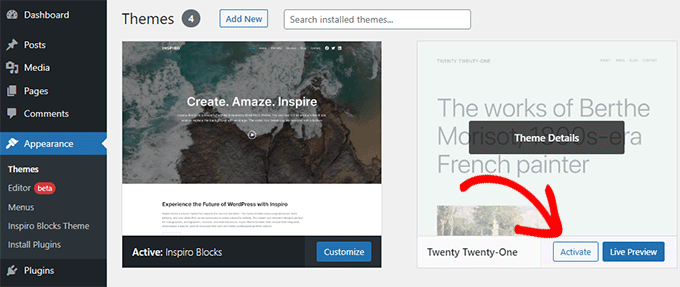
Se non avete installato un tema predefinito, potete fare clic sul pulsante “Aggiungi nuovo” in alto e installare un tema predefinito (Twenty Twenty-Three, Twenty Twenty-Two e così via).
Se non avete accesso all’area di amministrazione di WordPress, potete comunque passare a un tema predefinito.
È sufficiente collegarsi al proprio sito web WordPress utilizzando un client FTP e navigare nella cartella /wp-content/.
Fare clic con il pulsante destro del mouse per selezionare la cartella dei temi e scaricarla sul computer come backup.
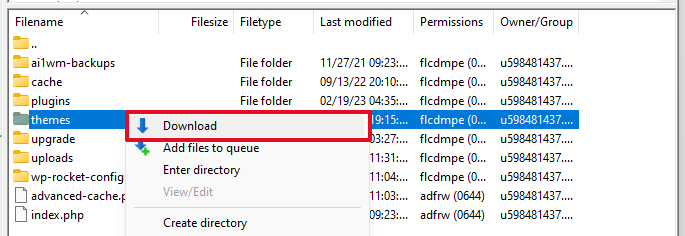
Successivamente, è necessario eliminare la cartella themes dal sito web. Una volta eliminata, creare una nuova cartella themes.
La nuova cartella dei temi sarà completamente vuota, il che significa che al momento non è stato installato alcun tema di WordPress.
Successivamente, è necessario visitare la directory dei temi di WordPress e scaricare un tema predefinito di WordPress sul computer.
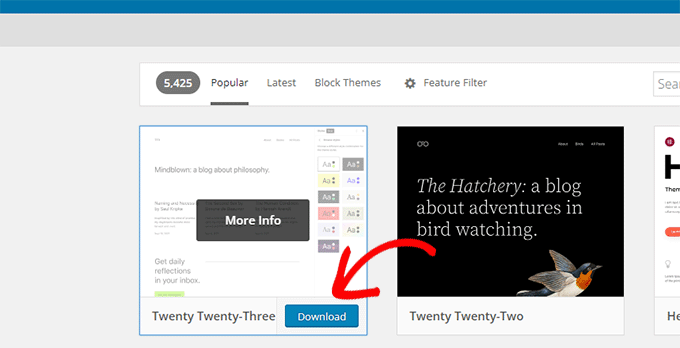
Il vostro browser scaricherà quindi il tema come file zip sul vostro computer.
Individuare il file sul computer e decomprimerlo. Gli utenti di Windows possono decomprimere il file facendo clic con il pulsante destro del mouse e selezionando “Estrai tutto”. Gli utenti Mac possono fare doppio clic sul file zip per estrarlo.
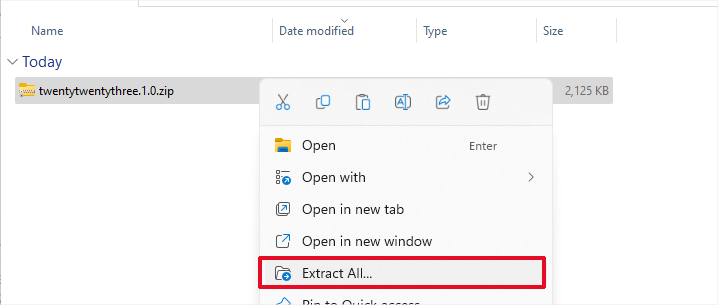
Ora vedrete una cartella contenente il vostro tema di WordPress.
Passare nuovamente al client FTP o al File Manager e caricare questa cartella nella cartella vuota dei temi.
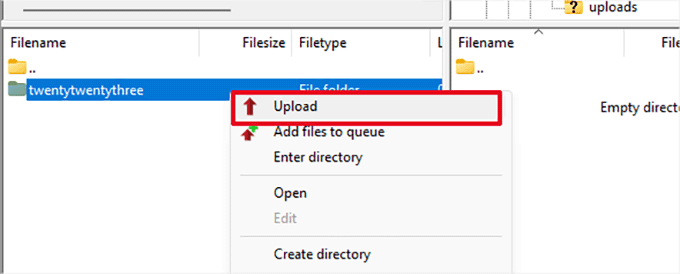
Una volta caricato, WordPress inizierà automaticamente a utilizzare il tema predefinito.
Ora è possibile visitare il sito web per verificare se l’errore del server interno è stato risolto.
Se non funziona, potete ricaricare i vostri temi WordPress dal backup o tornare al tema che stavate usando.
Non preoccupatevi. Ci sono ancora alcune cose che potete fare per risolvere l’errore.
Ricaricamento dei file del nucleo
Se le opzioni dei plugin e dei temi non hanno risolto l’errore interno del server, è opportuno ricaricare le cartelle /wp-admin/ e /wp-includes/ da una nuova installazione di WordPress.
Questa operazione NON rimuove le informazioni, ma può risolvere il problema nel caso in cui un file sia danneggiato.
Per prima cosa, è necessario visitare il sito web WordPress.org e fare clic sul pulsante “Download”.
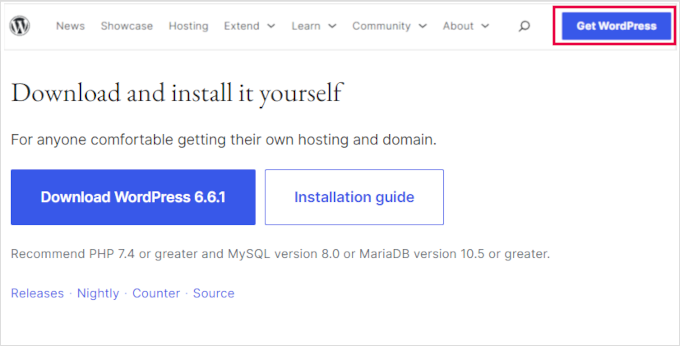
Questo scaricherà il file zip di WordPress sul vostro computer.
Procedere con l’estrazione del file zip. Al suo interno troverete una cartella wordpress.

Successivamente, è necessario collegarsi al proprio sito web WordPress utilizzando un client FTP.
Una volta collegati, accedere alla cartella principale del sito web. È la cartella che contiene le cartelle wp-admin, wp-includes e wp-content.
Nella colonna di sinistra, aprite la cartella WordPress sul vostro computer.
Ora è necessario selezionare tutti i file presenti nella cartella di wordpress e caricarli sul sito web.
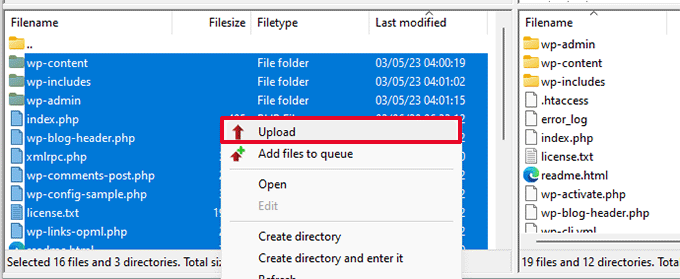
Il vostro client FTP trasferirà ora queste cartelle sul vostro server.
Verrà chiesto se si desidera sovrascrivere i file. Selezionare “Sovrascrivi”, quindi selezionare “Usa sempre questa azione” e selezionare la casella di controllo “Applica solo alla coda corrente”.
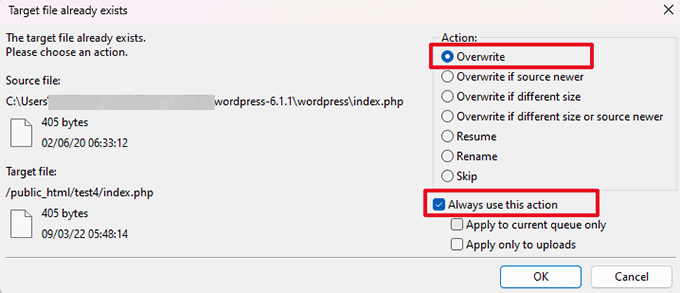
Il vostro client FTP sostituirà ora i vecchi file di WordPress con nuove copie fresche.
Se i file di WordPress sono stati danneggiati, questo passaggio risolverà l’errore interno del server.
Abilitare i log di debug in WordPress
WordPress è dotato di un sistema integrato per mantenere i log per il debug.
È possibile attivarlo utilizzando il plugin WP Debugging. Per maggiori dettagli, consultate la nostra guida su come installare un plugin di WordPress.
Una volta attivato, il plugin attiva i log di debug sul vostro sito web WordPress.
Se non avete accesso all’area di amministrazione del vostro sito WordPress, potete attivare il debug aggiungendo il seguente codice al file wp-config.php:
1 2 | define( 'WP_DEBUG', true);define( 'WP_DEBUG_LOG', true); |
Una volta attivati i log di debug, è possibile visualizzarli utilizzando un client FTP e navigando alla cartella /wp-content/.
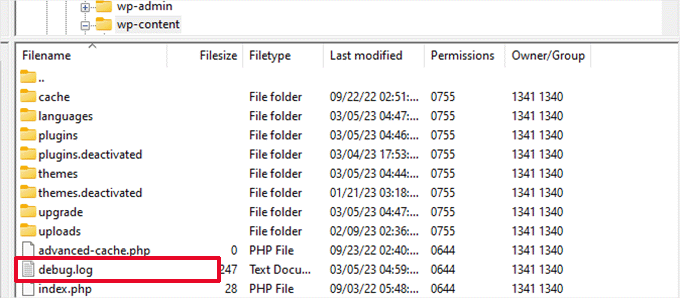
Il file di log di debug può essere aperto in un editor di testo e mostrerà un elenco di errori e avvisi che si verificano sul sito web.
Alcuni errori e avvisi possono essere incidenti innocui che non devono essere risolti. Tuttavia, se il vostro sito web presenta un errore interno del server, questi possono indicarvi la giusta direzione.
Chiedete al vostro fornitore di hosting
Se tutti i metodi non riescono a risolvere l’errore interno del server sul vostro sito web, allora è il momento di chiedere aiuto.
Contattare il team di assistenza del web hosting, che sarà in grado di controllare i registri del server e individuare la causa principale dell’errore.
Se volete continuare a risolvere i problemi da soli, consultate la nostra guida definitiva alla risoluzione dei problemi di WordPress per i principianti.
Video tutorial
Se questo articolo vi è piaciuto, iscrivetevi al nostro canale YouTube per le esercitazioni video su WordPress. Potete trovarci anche su Twitter e Facebook.





Ivan
Also, how to create an .ini file on a mac???
Ivan
What if it’s NOT the .htaccess file? Can we then change the filename back .htaccess??
What if it’s NOT the plugins? Can we simply change the plugins folder name back to what it was??
These are details we should know about.
Thanks!
WPBeginner Support
Yes, if it was not due to plugins folder or .htaccess, then you can put them back as they were.
Admin
gks
thanks this was so helpful.
philip
Thankyou so much, I had installed a plugin which had somehow corrupted the .htaccess file, renamed it to .htacces_old as per the advice on this page, and all’s back working again, if you cant find the .htaccess file on your server, it could be hidden, cpanel has an option to look for hidden files.
thanks guys
Akinshola Samuel
When all the files in your “wp-content” are empty, you always get the server (both locally and remotely). Took me longer time before recognising this.
I was moving the an existing wordpress engine alognside many other things, Unfortunately the wp-contents and it’s respective folders were all empty.
Finally, Happy when I solve this.
Max B
Thank you guys for saving my day! This solved the issue for me, thank you!
Sofia Berglund
Thanks! Great tutorial. Turned out for me that, when I was unactivated the plugins, I got another error-message saying i had some corrupt @media print-code in the functions.php. Took that away and got my page back
Donald
Make sure index.php has permissions of 644. Somehow mine has 777 when transferred from one server to another.
John
DONALD !!! you’re a life saver … thanks to the WP beginner platform also
Lewis James-Odwin
Great Video, solved my problem in 54 seconds! (.htaccess issue)
Keek
I must have spent 4 hours trying everything I found online. In the end, turns out I was running an old version of PHP. When I updated it in my cPanel, the 500 error was gone.
krishna
Internal Server Error
The server encountered an internal error or misconfiguration and was unable to complete your request.
Please contact the server administrator, webmaster@ and inform them of the time the error occurred, and anything you might have done that may have caused the error.
More information about this error may be available in the server error log.
Additionally, a 500 Internal Server Error error was encountered while trying to use an ErrorDocument to handle the request.
how to solve this error?
M Jones
My problem was actually a corrupt wp theme rather than a corrupt plugin.
To solve I renamed the corrupt theme (Oxygen) (which gave me a white screen) than named Twenty Sixteen “oxygen” so that my site would use Twenty Sixteen (a working theme) as my theme. Than I switched using dashboard to Twenty Fourteen (my second favorite installed theme) than again used my file editor to rename Twenty Sixteen back to “twentysixteen” & Oxygen to “oxygen.corrupt”.
I think my theme did not download properly, making it corrupt.
Thanks for pointing me in the right direction!
Alia
Thank you so much you saved me a lot of time!
mayur
Thank you so much for so complet information!
i have a .htaccess problem.. solved.. now working as charm..
SHYOPAT
Someone pointed me to your article (thank heavens) I did the htaccess file change and it helped it for two minutes. Then I did the php memory thing and that helped for a few minutes as well, then back to the internal server error. I’m currently working on trying to figure out if it’s a plugin. If that doesn’t help… then I’ll do the core files. And then after that… I have no idea. I guess I’ll try my hosting provider again.
Den
I always check .htaccess file first…
Will Paro
Is it possible to have an Internal Server Error only on select computers, but not others?
That is the issue I’m dealing with right now.
I have 6 sites all hosted through one account via GoDaddy. All are showing an Internal Server Error. They were fine this morning, but now nothing.
Problem is that GoDaddy says that they see the sites just fine.
I can pull the site up in gtmetrix.com and analyze it with no issues.
Please help.
Every computer I use PC, Macs and Chromebooks all show internal server errors, but gtmetrix.com and GoDaddy says everything is fine.
One of the sites is
Thanks in advance
Jesu
You save my life!!
Thanks a lot from Spain!
antony agnel
Phew…thanks a lot guys!
A new guy here…installed ‘bulletproof security’ plugin on my wordpress site & got an Error 500!
Was shit scared…& finally found out about your site and this article – finally fixed it by applying your tip to rename to .htaccess file to .htaccess_old!
Once again, thank you so much – you guys rock!!
hendra
Hi Guys
I have a questions in regards of 500 internal server error, i experienced the problem with a plugins [JSON API] when i type example.com/api/ – it is showing 500 internal server error.
any advises on how to solve this problem? much appreciated before.
Linda
Thank you!
In my case, it was the theme that was broken (my fault for tinkering around), not a plugin. I renamed the theme folder .mytheme-deactivate like in your plugin example, and hallelujah, I could access my site again! (I simply activated a different theme, but I could probably uninstall and re-install the original theme if I wanted to)
Aviroop Chowdhury
Disabling solved my issue. Thanks.
Mike
Sometimes this is a bug in your own PHP code.
For this it’s best to use a binary chop ‘echo’ method. That is add a simple echo ‘fred1’; exit; into your code starting at the top of the index.php. If you see ‘fred1’ displayed when you visit your site then you know it’s a PHP bug and not any of the other reasons. (Note I used a .htaccess online validator to check the syntax of my .htaccess file too, in order to rule that out).
Once ‘fred1’ is displayed now move it halfway down the index.php file (useful to increment the integer each time too, e.g. fred2, fred3 etc). If the server error occurs then you know you need to move the statement up. If fred1 etc is printed then you need to move it further down the code. If you get to an include or require statement then you then delve into that file in the same way.
I found the offending PHP file in under 10 minutes. You should then use php -l whateverfile.php to find offending line in that file and also to know what the syntax error is. If ‘php -l’ doesn’t give you the syntax error then you should read this:
The ‘php -l’ would need to be done by remote logging into your hosting account. If you can’t do this then as this article says, contacting your hosting support can be useful to find the php log file.
Darrin
You’re a life-saver! Renaming my plugins directory worked. Thank you!
Peter Ishola
I have tried all the options given in this article but it’s still the same. the error message appears on both the admin and the web pages of my site. I’d appreciate more options to solve this problem. The error message is:
500 – Internal server error.
There is a problem with the resource you are looking for, and it cannot be displayed.
Thanks
Kristoff
I am running a large WooCommerce store and was receiving 500 internal server error on most front end pages & WP admin login. The store resides on a dedicated cloud server and had been running fast without fault for a few months. Tried ht access remedy firstly, but nothing changed, php memory should not have been a problem as I had increased this on install & I did not think WP ftp core files were corrupted, so looked elsewhere. Ran putty to connect to dedicate linux server and command line was showing huge CPU usage for mysql – 90%. Previously in my WP development experience sql errors or high usage are database related, so via a combination of sql workbench to kill connections & php myadmin to repair database tables (I only repaired wp_options in this instance) I was able to fix the internal server problem. My point on all of this is – even though problem was flagged as internal server error, it was a database table repair (after table analysis) which cleared the error.
sahni
Can you write in detail how did you do fix wp_options
Saheed
Thanks a lot, deactivating plugins solved my issue
Dan
Hey Guys ,
I have this problem right now with some site and it looks like it is because server is overloaded and website is on shared hosting, so keep an eye on that !
Janus
Thanks i think you are right, i tried all above solutions but nothing helped, and i have pinge my site to a lot of search engines today so can be robots from there that have made the error.
Julian
Thank you! Deactivating the plugins vía PhpMyAdmin worked for me!
Monayam Ahmad
Not work for me. I face this problem when I want to customize my theme. Everything goes well. But to do ‘customize’ I get this error. I don’t why.
Ben
Thank you very much for this very helpful article !
The htaccess renaming worked for me ! Yeah !
Joe
Thank you so much! I was encountering endless Internal Server Errors for about 36 painful hours, and deleting/reuploading my theme via FTP then renaming the .htaccess file SAVED ME SO MUCH!
You are a life saver.
oladayo
Thank you very much. it was the option of re-uploading the wp-admin and include folders that saved me after about 3weeks of troubleshooting.
Rod Salm
For me, it was the permissions setting for the entire directory. It needed to be 750. Soon as I changed that in the File Manager in cPanel it was back up.
I didn’t figure that out on my own.
Rod
Giorgio
Thank you so much! You save me from an heart attack…
Simply I have renamed, via FTP, the .htaccess in .htaccess_old, and WP goes on.
This is the new .htaccess, created as you suggested:
# BEGIN WordPress
RewriteEngine On
RewriteBase /
RewriteRule ^index\.php$ – [L]
RewriteCond %{REQUEST_FILENAME} !-f
RewriteCond %{REQUEST_FILENAME} !-d
RewriteRule . /index.php [L]
# END WordPress
This is the .htaccess that I find in my FTP and renamed in .htaccess_old:
## BEGIN WordPress<
RewriteEngine On
RewriteBase /
RewriteRule ^index\.php$ – [L]
RewriteCond %{REQUEST_FILENAME} !-f
RewriteCond %{REQUEST_FILENAME} !-d
RewriteRule . /index.php [L]
# END WordPress
I don’t know what had modify the file. Someone have an answer?
Thank you!
Donny
I think it is a # problem, because your old file has 2 # and the new 1 # in the beginning.
Hope it helped
Oderinde Taiwo Martins
I just want to say a big thank you to you guys. You saved my day with this article. I’m bookmarking this website now as I know I will have to come back and learn more from your resources. Thanks a bunch.
Rionize
tkank’s guys every thing is on .htaccess file and pemalink in word press check it out!!!
Petrus Rex
I had this issue after a fresh install of WordPress. I would get this error specifically when accessing the plugins from my dashboard it turned out to be a corrupt .htaccess file but had to be handled server side by my web host. I’m running on Arvixe.
abbas
thanks
Ivan Aliku
I must give kudos to the moderators and content developers of this blog. I’ve not regreted knowing this website for one bit. The .htaccess solved the problem for me with ease. Keep up the good work.
Being Khan
I can’t rename it even.
Petrus Rex
You can change the name with an FTP client after you transfer it to your web host.
Usman Aslam
Thanks a lot, it was due to a bad plugin I couldn’t login, Wouldn’t have been possible without reading this. Great work … !
Larah31
Thanks man.. You’re the best
Cory
Thanks, renaming .htaccess to .htaccess.old did the trick :).
Mitch
I’ve got a weird one. My Internal Server Errors only happen on “Posts”, and Not on “Pages”. The host just updated the PHP version as well as the memory limit, and I re-uploaded the wp-admin and wp-admin files. No luck. Any other ideas?
James
I have the same issue. None of these things fixed it for me either.
josh
thanks this was helpful
mark
.htaccess did the thing for me. Thanks!
Juan mejia
Thanks!!!! htaccess in my case.
Cachi
Thanks, It solved in my case. Just delete de .htaccess , reload, and a new .htaccess file was generated and the site works !
Thank you again
Rochelle
I have been in touch with my hosting provider two times and they have no idea what it is. They switched databases, thought it was hacked, and the other guy couldn’t figure out why I was having problems at all.
Someone pointed me to your article (thank heavens) I did the htaccess file change and it helped it for two minutes. Then I did the php memory thing and that helped for a few minutes as well, then back to the internal server error. I’m currently working on trying to figure out if it’s a plugin. If that doesn’t help… then I’ll do the core files. And then after that… I have no idea. I guess I’ll try my hosting provider again.
Would switching hosts be of any help at all?
WPBeginner Support
If all these steps don’t help and your host is unable to assist, then yes you can consider switching to a better WordPress hosting.
Admin
Adela
Thank you so much for so complet information!
It was a plugin problem for me, impossible to find without your help!